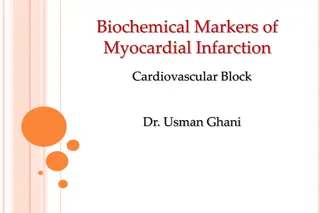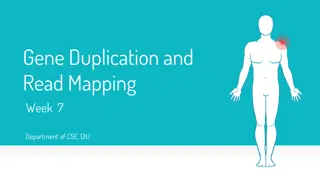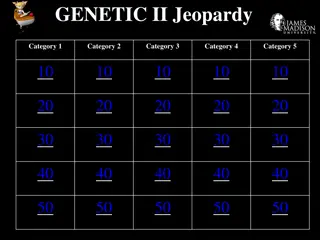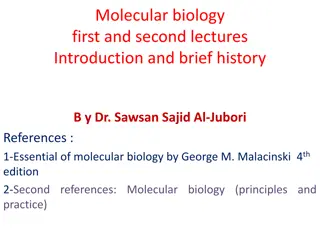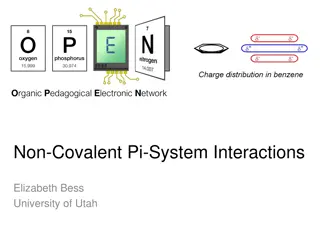Understanding Genetic Markers in Molecular Mapping
Genetic markers play a crucial role in gene mapping within molecular biotechnology. They are fragments of DNA associated with specific genomic locations, aiding in identifying DNA sequences and analyzing genetic variation. Various types of genetic markers such as RFLP, SSR, and SNP offer insights into dominance, co-dominance, and allele variations, allowing for detailed genetic mapping and trait analysis. Understanding the significance and categories of genetic markers enhances the precision of genetic research and biotechnological applications.
Download Presentation

Please find below an Image/Link to download the presentation.
The content on the website is provided AS IS for your information and personal use only. It may not be sold, licensed, or shared on other websites without obtaining consent from the author. Download presentation by click this link. If you encounter any issues during the download, it is possible that the publisher has removed the file from their server.
E N D
Presentation Transcript
In marker (identified as genetic marker) is a fragment of DNA that is associated with a certain the genome. Molecular markers are used in molecular biotechnology to identify a particular sequence of DNA in a pool of unknown DNA genetics, a molecular location within biology and
There are many types of genetic markers, each with particular limitations and strengths. Within genetic markers there are three different categories: "First Generation Markers", "Second Generation Markers", and "New Generation Markers".[5]These types of markers may also identify dominance and co-dominance within the genome.[6]Identifying dominance and co-dominance with a marker may help identify heterozygotes from homozygotes within the organism. Co- dominant markers are more beneficial because they identify more than one allele thus enabling someone to follow a particular trait through mapping techniques. These markers allow for the amplification of particular sequence within the genome for comparison and analysis.
List of Markers Acronym Restriction Fragment Length Polymorphism RFLP Random Amplified Polymorphic DNA RAPD Amplified Fragment Length Polymorphism AFLP Variable Number Tandem Repeat VNTR Oligonucleotide Polymorphism OP Single Nucleotide Polymorphism SNP Allele Specific Associated Primers ASAP Inverse Sequence-tagged Repeats ISTR Inter-retrotransposon Amplified Polymorphism IRAP
What can be used as genetic markers in gene mapping? Some commonly used types of genetic markers are: RFLP (or Restriction fragment length polymorphism) SSLP (or Simple sequence length polymorphism) ... SSR Microsatellite polymorphism, (or Simple sequence repeat)
Restriction Fragment Length Polymorphism (RFLP) Restriction Polymorphism (RFLP) is a technique in which organisms may be differentiated by analysis of patterns derived from cleavage of their DNA. If two organisms differ in the distance between sites of cleavage of a particular restriction endonuclease, the length of the fragments produced will differ when the DNA is digested with a restriction enzyme. The similarity of the patterns generated can be used to differentiate species (and even strains) from one another. Fragment Length
mapping with molecular markers, mapping by using somatic cell hybrids
Amplified Fragment Length Polymorphisms (AFLPs) are differences in restriction fragment lengths caused by SNPs or INDELs that create or abolish restriction endonuclease recognition sites. The AFLP technique selective PCR amplification of restriction fragments from a total digest of genomic DNA. is based on the
What is somatic cell hybridization? Somatic hybridization is a technique which allows the manipulation of cellular genomes by protoplast fusion. Its major contribution to plant breeding is in overcoming common crossing barriers among plant species and in organelle genetics and breeding.
Flourescence-activated chromosome sorting The single chromosome can then be added to a mouse cell line, and either the whole chromosome is taken up intact or fragments of the chromosome become integrated into the mouse chromosome. Alternatively, a human cell line can be irradiated with X-rays before fusion. Most often the fragments become incorporated into the mouse chromosome, although a fragment may be maintained as its own partial chromosome. These lines are called radiation hybrids.
Human-Rodent Somatic Cell Hybrids - Mapping Human Chromosomes Somatic cell hybrids are culture lines that contain the entire complement of the mouse genome and a few human chromosomes. These culture lines are developed by mixing human and mouse cells in the presence of the Sendai virus. The virus facilitates the fusing of the two cell types to form a hybrid cell. For a reason that is not entirely known, most, but not all, human chromosomes are lost from the hybrid cell lines. Usually a few human chromosomes are retained. Because the human and mouse chromosomes can be distinguished by chromosome staining techniques, it can be determined which human cells are retained with a specific cell line. Typically, the mouse cell line is mutant for a specific function. Because the hybrids are selected on cells in which the mutant cells could not grow, any surviving hybrid lines would contain the human chromosome that complements (or rescues) the mouse mutation and several other human chromosomes. Once a complement of hybrid cell lines is developed, a DNA marker can be assigned to specific chromosome. If a DNA marker hybridizes to DNA from a specific line, it must be located on one of the chromosomes in the hybrid. By analyzing the hybridization pattern in a number of lines, the DNA marker can be assigend to a specific chromosome. Let's look at the data in the table below and determine on which chromosomes might DNA markers A, B, and C reside.
The genes that are carried on the Y chromosome are called holandric genes. Holandric genes can only be passed by males onto their sons; they code for 'maleness' but sometimes cause rare conditions like hypertrichosis pinnae and color blindness.






